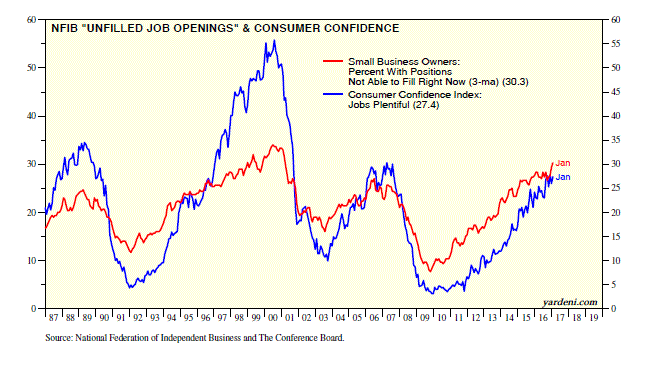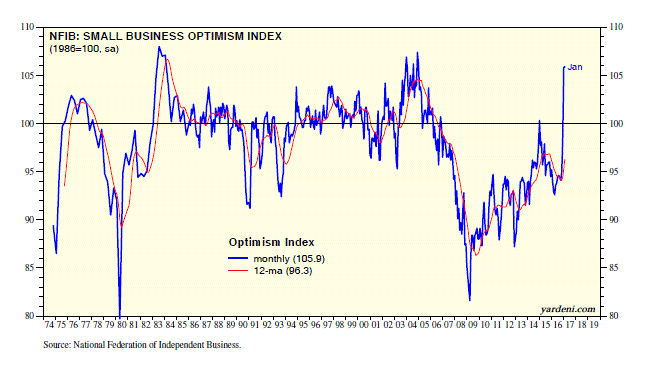There is only one obvious explanation for the remarkable vertical ascent in the Small Business Optimism Index over the past three months through January: Donald J. Trump. The index, which is compiled by the National Federation of Independent Business (NFIB), jumped from 94.9 during October to 105.9 during January, the highest since December 2004. That 11.0-point increase is reminiscent of a comparable leap higher during 1980 when business owners started to anticipate that Ronald Reagan might beat Jimmy Carter in that year’s November presidential election. There was another similar outsized increase during 1982 and 1983 when Fed Chairman Paul Volcker lowered interest rates to revive the economy from a severe recession.
Small businesses add up to a big portion of our economy. They currently employ 49.9 million workers, accounting for 40.5% of private-sector payrolls, according to data compiled by ADP. Since the start of the data during January 2005, small business payrolls have increased by 5.9 million, surpassing the gains by medium-sized (5.0 million) and large (1.2 million) companies over the same period. Here are a few of the key highlights from the latest NFIB survey:
(1) Problem solver? Each month, the NFIB survey includes a question on the most important problem faced by small businesses. Since early 2013, taxes and government regulation have been alternating between first and second places. Trump has pledged to lower both for small businesses. Apparently, small business owners expect that’s what he will do. Now all he has to do is deliver.
(2) A new problem. The NFIB survey also lists “poor sales” as a problem. That was the number-one complaint from October 2008 to July 2012. The survey doesn’t ask about the availability of labor. Nevertheless, that is actually becoming a big concern among small business owners according to another question in the survey. During January, roughly 30% of them said they have job openings that they aren’t able to fill right now. That’s the highest such reading since February 2001 based on a three-month average. It confirms that the economy is at full employment, as also evidenced by the unemployment rate, which is inversely correlated with this series and has been below 5.0% for the past nine months through January.
(3) Wages, prices, and profits. The NFIB’s jobs-hard-to-fill series is also highly correlated with the jobs-plentiful series included in the Conference Board’s survey of consumer confidence. All these labor market indicators suggest that wage inflation should be running hotter.
So far, there isn’t much evidence that wage inflation is picking up in the average hourly earnings data that are released by the Bureau of Labor Statistics in the monthly employment report. Previously, I have shown that there is more wage pressure showing up in the Atlanta Fed’s Median Wage Tracker.
In any event, so far over the past six months on average, only 3.3% of small business owners said they were actually raising their selling prices. So far, I am not seeing any pressure on the forward earnings of the S&P 600 SmallCap’s stock composite, which is rising in record-high territory. However, the composite’s forward profit margin is currently down to 5.2% from a cyclical peak of 6.1% during October 2013.


